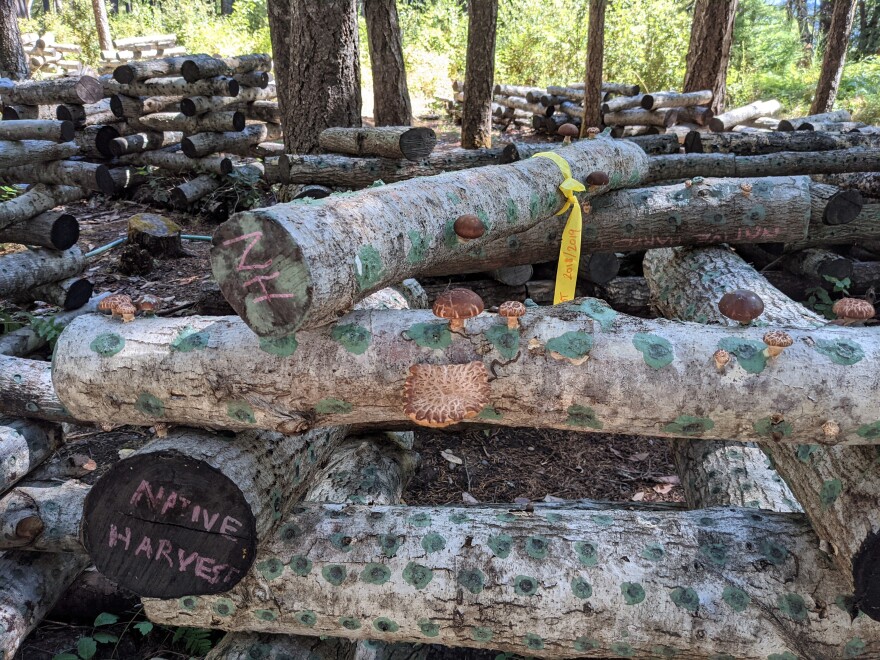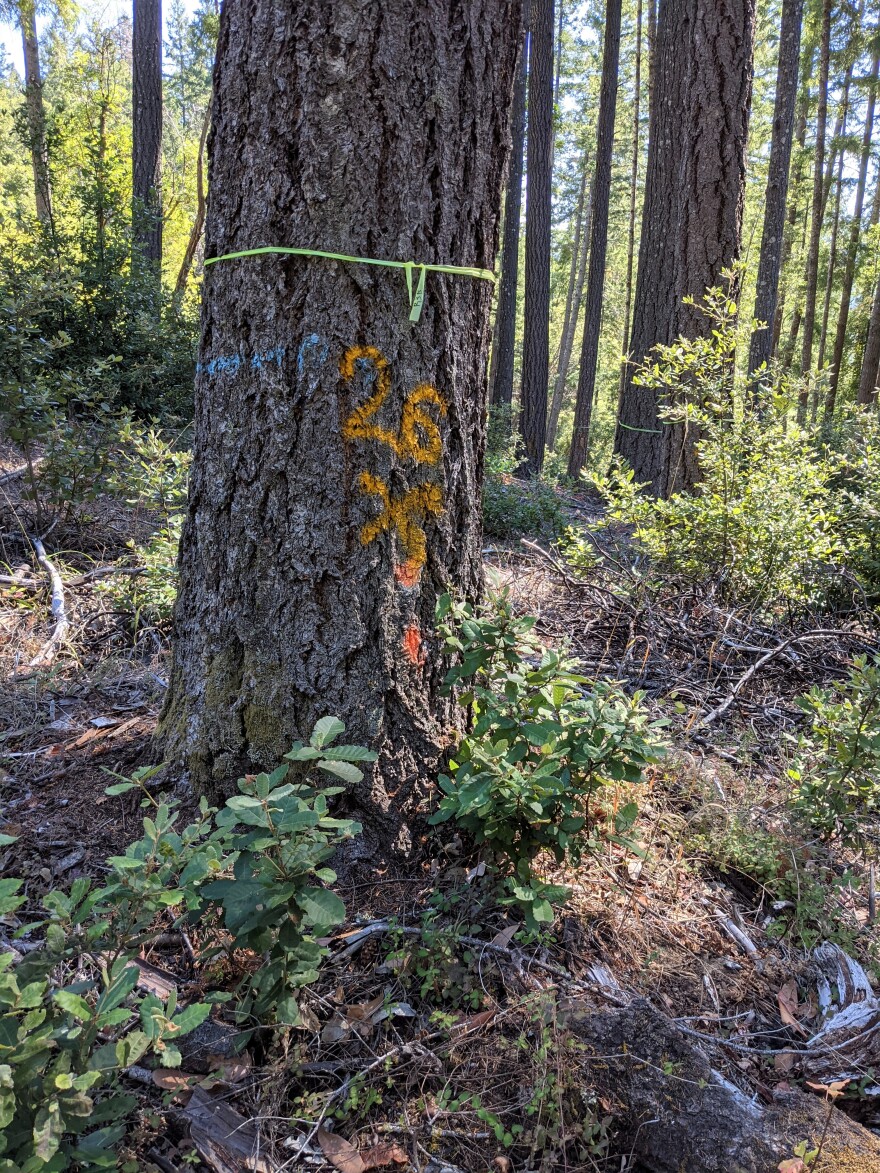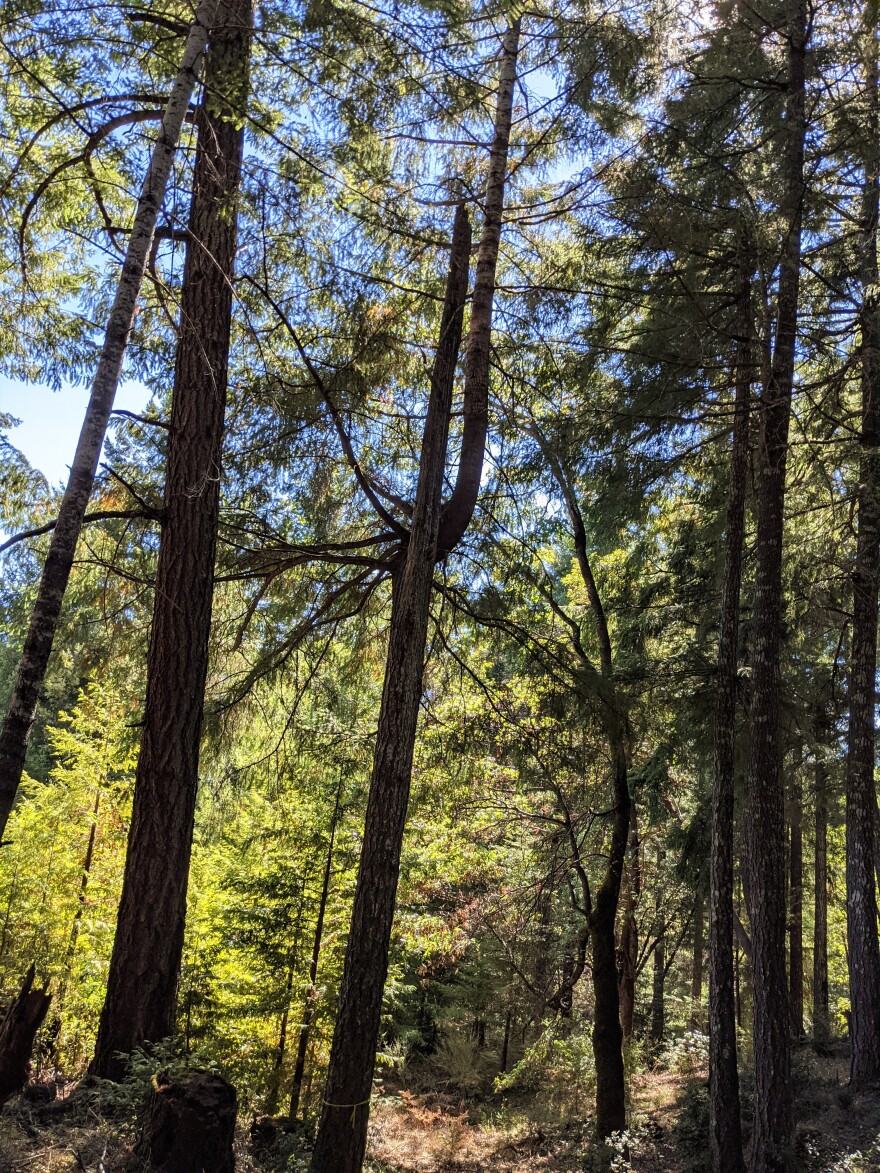September 28th — PG&E’s plans to clear cut around power lines on private property are not limited to Mendocino County. This weekend, KZYX paid a visit to Harry Vaughn, a small landowner in Southern Humboldt, just outside Miranda, where crews have been marking trees for removal. Vaughn depends on the income he makes from farming mushrooms in the woods and from small-scale logging, “which is one reason I don’t really want the contractors to come in and destroy the value of my forest, where they would cut thousands of dollars of timber, and just leave it on the ground to rot,” he explained.
Vaughn manages his 240 acres of mixed canopy for fire, sudden oak death, and sustainable logging
according to a non-industrial timber harvest plan.

He also farms more than twenty varieties of mushrooms in frames made from tanoak saplings in a patch of scrupulously maintained dappled shade between a fuel break and a dirt road. He was careful to acknowledge that we were on Wailaki land before we made our way over to a mushroom that looked like a small turtle balanced on a log. It was a bellflower, or winter variety, shiitake. He calculated that he can make upwards of sixteen dollars a pound for mushrooms at market. “I can grow mushrooms and grow trees and harvest trees to provide income for me and jobs for my neighbors,” the local loggers he hires to work on the property. He also uses a local mill to process the wood into lumber.
Across the dirt road from the mushroom farm is a patch that’s been judiciously opened up to allow for different kinds of forest foods. But it’s still not nearly as opened up as the PG&E clear cuts in Mendocino County. “Once you remove the shade from the shaded fuel break, you end up with a brush field that’s more prone to fire, which is basically what PG&E is proposing to do, is create huge brush fields,” said Vaughn, who is a member of the local fire safe council and the prescribed burn association. Pausing at the sunny patch where trees had been thinned, he pointed out the native food-bearing species that thrive in that set of conditions: low-growing blackberries, black raspberries, huckleberries, and acorn-bearing oaks. “It’s making more food for me and more food for the animals,” he observed. In order to maintain it all, “I don’t want to open it up too much, because then the invasive species will come in and the fire danger really goes up.”
PG&E’s enhanced vegetation management program received approval from the California Public Utilities Commission in 2018. The stated purpose of the work is to reduce fires, but there was no environmental review, and there’s been no agency oversight. Ag ponds and watersheds downhill of the clear cuts are in danger of getting clogged with sediment when the rain starts, and the four to six inches of chips left in pastures could have an economic impact on ranchers. But for Vaughn, the clear cuts would have a direct and devastating impact on his bottom line.

Using the rough estimate of five hundred dollars for a thousand board feet of Douglas fir, he figured that he and his neighbor the logger could each make about two hundred fifty dollars from one high-value fir. One particular tree was marked with an inscrutable set of numbers and different-colored dots, plus a yellow X that seemed to indicate it had been selected for removal. It’s one of seven hundred trees PG&E contractors have marked on Vaughn’s property. He hasn’t worked up the exact loss plus damages he would incur if the company removed all the trees it deemed a danger to its infrastructure, but his estimate of the loss along one power line would be between sixty and eighty thousand dollars. “Seven hundred trees is a lot of trees to lose,” he reflected.
As a professional woodsman, he doesn’t have a high opinion of how the company’s contractors work in the forest. “The contractors that refused to identify themselves told me the yellow X’s mean they’re going to cut that tree,” he said. “And then they said that the spots were just a trim, but I’ve noticed in some reports that you showed that spots mean trim it to the stump. Trim it to the ground, so nobody quite knows what their marks mean. And they haven’t explained that.”
A few paces up the road, Vaughn pointed out where he had found several unattended PG&E contractor trucks in a turnout, one of them idling in dry grass. “So they actually posed a threat to us during fire season,” he reported.
It’s not the only way the contractors have already endangered community members. Vaughn says they have come to his door during the pandemic without masks. “And I asked if they had been vaccinated, and they got in my face, and said it was none of my business,” he recounted. “The guy that got in my face actually had a Texas license plate, so he had a, maybe I’m biased, a Texas attitude.” Regional differences aside, Vaughn wondered why contractors are traveling such great distances to perform the work, and speculated that they are incurring massive mileage and per diem costs.
In addition to providing his livelihood, part of the woods also serve a scientific purpose. Vaughn has a masters degree in watershed management, and showed me where he restored a tributary as part of a thinning project. In 2006, he devoted a grove of tanoaks on the edge of an oatgrass meadow to a UC Davis study of sudden oak death. Scientists came out this summer to re-survey the test plots, to monitor changes over time. Vaughn has also welcomed scientists from Oregon and England, who wanted to study the effect of sudden oak death on rhododendrons. As we crossed the meadow beneath the power lines, a small flock of turkeys slunk off down the hill.
All the trees in the grove were marked for removal. “It’s kind of a shame, since we worked since 2006 and there’s been all this scientific research that is even across the big pond in England for the knowledge that we’re gaining here to have the PG&E contractors come through and cut down our success story on saving our tanoaks,” he said ruefully.

Just beyond the test plot, a tall fir tree with a main branch like a bent arm was marching crookedly
down the hill. It’s a technically flawed tree, though the crook of the arm is an ideal nesting site. It, too, was marked for removal, though it was hundreds of feet from a power line and much more likely to fall down the hill than up. Vaughn described it as a wildlife tree, and said a professional forester would know that and leave it alone. “That’s a problem with the enhanced vegetation management program,” he declared. “They’re hiring arborists that actually don’t know about forestry. And they’re practicing forestry in California without a license. And I think that that’s not right.”
Audio interview with Harry Vaughn





